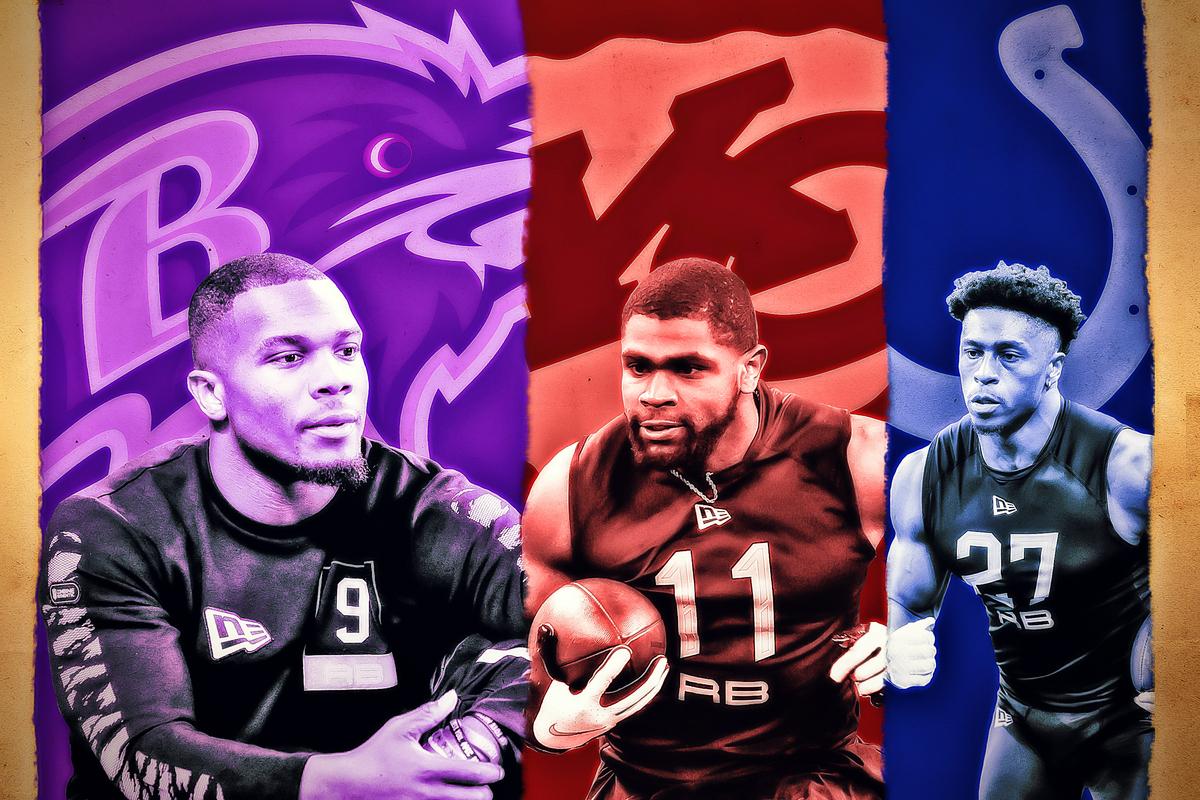
The 2020 draft featured a deep running back class and an even deeper wide receiver class, and now that players have settled onto their respective teams we can finally assess the fantasy landscape. While the quarterbacks in this group may be with us for a decade or more, they don’t look poised to be immediately fantasy relevant. Tua Tagovailoa may not start in Miami to begin the season as he continues rehabbing from an injury, while Justin Herbert is likely to enter 2020 behind Tyrod Taylor on the Chargers’ depth chart. (Jordan Love will certainly ride the bench in Green Bay.) Joe Burrow is the only rookie quarterback more likely than not to start in Week 1, and his fantasy potential seems limited both by his team’s supporting cast and his lack of steady rushing production. This was also a weak tight end class, and tight end is a notoriously difficult position to make an instant impact at: Only eight tight ends have surpassed 80 fantasy points in their rookie seasons in the 21st century.
That leaves running backs and receivers as the main positions to examine through a fantasy lens, and there are some players who could help win leagues this fall. Let’s break down eight of the most intriguing rookies and the fantasy upside their situations carry.
Running Backs
Clyde Edwards-Helaire, Kansas City Chiefs
“Clyde.”
That’s what Patrick Mahomes texted Chiefs general manager Brett Veach when Veach asked him who he wanted the team to select with its first-round pick, according to ESPN’s Adam Teicher. Veach agreed, and Kansas City made Edwards-Helaire the final pick of the first round and the first running back selected in the draft. None of the backs taken after him landed in a place better suited to their skill sets—or their quarterback’s preference—than Edwards-Helaire. He thrives in the shotgun, and the Chiefs ran the second-most shotgun snaps in the NFL last year. He’s effective as both a rusher and a receiver, and blocks at a high enough level that he should get plenty of playing time as a rookie. He forced a missed tackle every 2.7 touches during his 2019 season at LSU, the most of any running back in this draft class, according to Pro Football Focus. He also led the running backs in this class in targets (64), catches (55), and receiving yards (453).
“With [Edwards-Helaire], his strengths are his ability to run the zone scheme and the gap scheme that they did at LSU,” Chiefs coach Andy Reid told reporters after the pick. “He has a unique ability to push the line of scrimmage in the run game and make his lateral cut and then accelerate up the field. I’d tell you that’s kind of what separated him from the other guys.”
Any running back who gets significant playing time for the Chiefs is valuable from a fantasy perspective. In 2017, Kareem Hunt led the NFL in rushing as a rookie and finished as a top-three fantasy player. Edwards-Helaire should be especially valuable in PPR leagues. The question with him, as with many fantasy running backs, is how much he’ll play. “You can’t do it with just one guy in today’s football, so we’ve got a whole lot of these guys now,” Reid said.
Those guys include Damien Williams, who had 21 touches for 133 yards in Super Bowl LIV, including two touchdowns in the final three minutes. Veach told reporters that he envisions Edwards-Helaire helping the team on first and second down, specifically, so Williams and Edwards-Helaire are likely to split the majority of Kansas City’s touches, with the other members of the Chiefs backfield slotting in behind them. LeSean McCoy’s contract expired after last season. DeAndre Washington, Darrel Williams, and 2019 sixth-rounder Darwin Thompson will probably compete for the third- and fourth-string gigs while the fifth-place finisher will likely get released. The Chiefs’ high-powered offense has made several running backs fantasy relevant over the past three years, but soon one guy could be the star: Clyde.
Jonathan Taylor, Indianapolis Colts
If you’re looking for a rookie who can take over a backfield and put up RB1 numbers, Taylor is your guy. In 2017 at Wisconsin, he racked up 1,977 yards to break Adrian Peterson’s freshman FBS rushing record. Taylor then surpassed 2,000 rushing yards in both his sophomore and junior seasons, recording 12 games of 200-plus rushing yards, the most in college football history. He is one of seven running backs in FBS history with more than 6,000 rushing yards, and he’s the only one to reach that mark in just three seasons. If Taylor hadn’t declared for the draft, he likely would have left Wisconsin as the leading rusher in college football history.
Of course, college stats don’t always translate to the NFL. The FBS all-time leading rusher is former Wisconsin back Ron Dayne, who barely made a dent in the league after being drafted in the first round in 2000. Former Wisconsin star Montee Ball, who ranks second on the career rushing touchdowns list, made an even smaller NFL impact than Dayne. One of the reasons that Wisconsin running backs fare so well on campus is the school is an offensive line factory, consistently producing top talent for the NFL. And that’s why Taylor’s future could be so different when compared to Dayne’s and Taylor’s: Landing in Indianapolis means Taylor will play behind one of the best offensive lines in the NFL.
Taylor clocked the fastest 40-yard dash time (4.39 seconds) of any running back at the combine despite being the third-heaviest in his class at the position. That speed will be devastating when he hits the holes the Colts line can create. “He has the size and speed to be able to have good vision,” Colts head coach Frank Reich told reporters this weekend. “And when he hits it, Jonathan Taylor is an explosive player. That size and 4.3 speed—we want to turn those 10-yard gains into 50- and 60-yard gains.”
Taylor will compete with Marlon Mack to win feature back duties in Indianapolis. His durability could give him an edge, as Taylor didn’t miss a start during his college career. Indy running back Nyheim Hines has carved out a pass catching role on third-and-long, and Taylor had nine drops in 68 targets at school, so he may not earn enough receiving work to be a dominant fantasy back.
“I envision that it’ll be Jonathan and Marlon being that one-two punch,” Reich said. “When you look at good teams over the years—it’s a long season. It’s a grind and when you run the ball as much as we run it, it’s really good to be able to change that up. I think their styles will complement each other very well.”
J.K. Dobbins, Baltimore Ravens
Last season, the Ravens had the most rushing yards (3,296) in NFL history and the highest yards per carry mark (5.5) in the Super Bowl era. Lamar Jackson didn’t need much help in that regard, but he got it anyway when Baltimore used a second-round pick on Dobbins, who many analysts pegged as the best running back in this year’s class. Dobbins ran for an Ohio State–record 2,003 yards last season, and excelled against top competition: In his final four college games, he ran for 157 yards against Penn State, 211 against Michigan, 172 against Wisconsin, and 174 against Clemson.
That doesn’t mean he’ll get the bulk of Baltimore’s snaps anytime soon, though. The Ravens had three players rush for more than 700 yards last season (Jackson, Mark Ingram, and Gus Edwards), just the second time in league history a team had three players accomplish that. Edwards is set to become a free agent after this season, and Ingram turned 30 in December, but each averaged better than 5 yards per carry in 2019, so supplanting them won’t be easy. Supremely talented running back Justice Hill is also on the roster; while Hill didn’t get many opportunities in 2019, another offseason of training could prompt Baltimore to use him more frequently.
There is no question that Dobbins could emerge as a top-10 fantasy running back if the Ravens ever handed him feature duties. But the crowded path to Dobbins seeing those snaps in 2019 at least slightly dampens his rookie appeal.
D’Andre Swift, Detroit Lions
The Lions drafted Swift with their second-round pick (no. 35) just two years after trading up to draft running back Kerryon Johnson in the second round (no. 43). It’s not a great development for either Swift or Johnson, who now have to duke it out for snaps on a team that has the fewest rushing attempts and rushing yards over the past five years (and the past 10 years, and the past 15 years …). It’s not great for the Lions, who probably could have filled a bigger area of need with the third pick of the second round, and instead have a glut of highly drafted running backs on a pass-first offense. And it’s not great for fantasy owners who will have to parse the usage of Detroit’s two second-round backs.
Swift—who dropped just three of 90 targets at Georgia—is far better in the receiving game than Johnson, so is likely to earn snaps in obvious passing situations. And Johnson has been limited to 18 games and 14 starts in two NFL seasons due to knee injuries, so just staying on the field could earn Swift the primary job. But volume is king in fantasy football, and Swift never surpassed 15.1 touches per game or 500 snaps in a season at Georgia. It’s unknown if he can handle more touches at a higher level.
Adding to the uncertainty is that the Lions’ third running back, the 6-foot-1, 235-pound Bo Scarbrough, could steal goal-line opportunities. (Scarbrough is big enough that he could be confused for Swift’s dad.) Detroit is an unexciting spot for an exciting player.
Cam Akers, Los Angeles Rams
Akers has a real chance to capture a huge portion of an NFL backfield’s workload right out of the gate. The Rams cut Todd Gurley last month, leaving just Malcom Brown, Darrell Henderson, and John Kelly between Akers and the starting job. Akers played behind a leaky offensive line at Florida State, preventing him from fully capitalizing on his speed. That experience could prove useful, as the Rams had one of the worst lines in football for stretches of last season.
The second-round draft pick has more than just speed, though; he also has burst. While we obsess over 40-yard dash times, a more telling metric for running back prospects is probably the initial 10-yard split, and Akers had a faster 10-yard split at the combine than every back besides Colts draft pick Taylor. Sean McVay can put that burst to good use.
Akers is also a standout in pass protection. He allowed just 15 pressures in 324 pass block snaps at Florida State, making him one of the best pass blockers at the position in the draft class. One of the hardest transitions for rookie running backs to make is often in pass protection, and Akers being strong in that area should keep him on the field. Jared Goff is a statue in the pocket and needs all the protection help he can get.
Wide Receivers
CeeDee Lamb, Dallas Cowboys
Lamb seems like a better real-life than fantasy fit in 2020. Amari Cooper has the no. 1 receiver spot locked down in Dallas, and the no. 2 job is held by the solid Michael Gallup. Lamb may come for Gallup’s targets soon, but it probably won’t be in 2020. So much of NFL passing success is about timing, and timing comes down to practice. In normal circumstances, rookies are behind the curve in getting into a rhythm with their quarterback, and nothing about 2020 is normal. Even if Lamb starts getting reps with Dak Prescott in August, that’s late to begin establishing a rapport. Lamb could surpass the 83 targets that the departed Randall Cobb had for the Cowboys in 2019, but it’s unlikely that he will be able to produce on a consistent basis. It’s unlikelier still that fantasy owners will be able to predict that production well enough to start him.
Dallas led the league in total yards last year, but still had just four startable fantasy players: Prescott, Ezekiel Elliott, Cooper, and Gallup. It’s hard to see Lamb cracking into that group. While his ceiling as the team’s no. 2 receiver behind Cooper is enticing, his floor as the no. 5 option behind Elliott, Cooper, Gallup, and tight end Blake Jarwin is worth keeping in mind.
Jerry Jeudy, Denver Broncos
Jeudy will likely fare better than Lamb as a rookie, if only because he has a clearer path to immediately becoming a top-two option in his offense. Jeudy is the most pro-ready receiver in this draft class, so theoretically the lack of offseason practice should hamper him the least. He also has the weakest depth chart in front of him. While Courtland Sutton, who had 124 targets last year, is entrenched as Denver’s no. 1 receiver, Jeudy will slide into the no. 2 spot nicely. Nobody else on the Broncos had more than 66 targets last fall, and no wide receiver had more than DaeSean Hamilton’s 52—and Hamilton might get released or traded. Jeudy is a decent bet to lead all rookie receivers in targets in 2020.
Henry Ruggs III, Las Vegas Raiders
The rookie receivers who made a fantasy impact early last year had one thing in common: speed. Whether Baltimore’s Marquise Brown or Washington’s Terry McLaurin, the speedsters overcame any early chemistry issues by sprinting wide, wide open. Ruggs ran a blazing 4.27-second 40-yard dash at the combine, showing off the speed that allowed him to score a touchdown on a quarter of his catches at Alabama. Ruggs fits the profile of the wideout fantasy owners want to take a shot on: He’s a burner who can turn a couple of big plays into scores and swing a fantasy matchup in the process.
But the Raiders have not been big-play creators with Derek Carr as their quarterback. In fact, Carr had the second-shortest average pass length in 2019, trailing only Saints backup Teddy Bridgewater. Carr tossed the ball more than 20 yards downfield on just 9.4 percent of his throws last year, the fifth-lowest percentage of any QB with at least 10 starts. Perhaps Carr hasn’t taken many deep shots because he’s had so few receivers to look for downfield. If that’s the case, Ruggs’s presence will fix that.
Betting on Carr isn’t cool anymore, but if Ruggs is able to get open, odds are that Carr has enough of an arm to hit him—and that could be enough to make Ruggs a high-upside lottery ticket worth stashing on the end of your bench.

